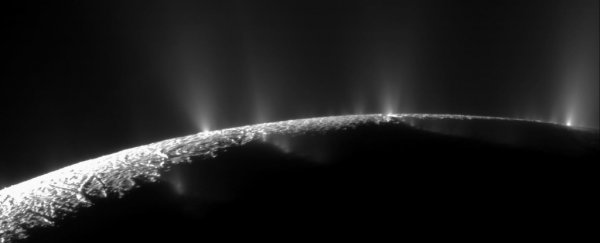Deep beneath its icy crust, the dark waters of Enceladus may be swirling.
According to a new analysis of the layer of ice covering the Saturnian moon's global oceans, currents very similar to Earth's appear to be flowing there. If so, this means that Enceladus's oceans may not be homogeneous after all.
Enceladus doesn't give up its secrets easily. Our first good look at it came in 1981, when Voyager 2 passed through on its way to the outer Solar System. The probe's images revealed a small ball of highly reflective ice, just 500 kilometers (310 miles) across, pocked with craters and scarred with long cracks and mountain ranges, suggestive of geological activity.
Then, in 2010, a huge surprise: Saturn probe Cassini discovered geysers of liquid water spraying from fractures in the icy shell of Enceladus - evidence that the moon wasn't ice all the way down, but harboring a liquid salty ocean.
The combination of liquid water and cracks in the ice helped scientists understand how Enceladus works. As Enceladus makes its elliptical, 1.37-day orbit around Saturn, the changing gravitational forces pull and stretch at the moon. This stress generates internal heating and geothermal activity, and creates cracks in the surface ice.
The internal heating keeps the interior ocean liquid, and it sprays out through the cracks as geysers, which fall to the surface and refreeze. That internal heating would also generate vertical convection currents - similar to those seen on Earth - sending warmer water upwards, where it would cool before circulating back down.
Because Enceladus is so different from Earth, though, it's unclear if its oceans may be similar in other ways, too. Earth's oceans are, on average, 3.7 kilometers (2.3 miles) deep. Enceladus's is at least 30 kilometers deep, and covered by 20 kilometers of ice.
We can't actually see what's happening in that ocean, but there are clues in the ice. We know that the ice is dramatically thinner at the poles than at the equator, and much more at the south pole, where the moon's geysers erupt. This, according to a team of researchers led by geophysicist Ana Lobo of Caltech, suggests there is something more complex than simply vertical convection going on in the ocean below.
Thinner ice is - probably unsurprisingly - likely associated with greater melting, and thicker ice with greater freezing. This means that, where the ice is thicker, the ocean is more saline, since only the water freezes, and most of the salts are released back into the water. This makes the water below the ice denser, so it sinks to the bottom of the ocean.
In melt regions, the opposite happens. The water is fresher and less dense, so it stays on the top. Here on Earth, this results in a sort of "conveyor belt" current. Water freezes at the poles, and the denser, saltier water sinks to the bottom and flows in a current towards the equator, while warmer waters from the equator flow to the poles where they are frozen, resulting in more dense cold salty water sinking, and so forth.
The team developed a computer model of Enceladus, partially based on our understanding of these conveyor belt currents, and the team found that a similar flow could reproduce the observed thicknesses in the moon's ice.
Now, it's unclear whether there's life on Enceladus. It's very far from the Sun, but, because of the internal geothermal heating, it may have chemosynthetic food webs similar to those found around hydrothermal vents in Earth's deep, dark oceans. If there is life hiding deep in the oceans of Enceladus, the team's findings may help us figure out where to find it.
We know that Enceladus's waters are salty; the water sampled by Cassini from the geysers revealed as much. If the team is correct, the salt levels in those geysers may actually be on the lower side, since they're ejected from the melt region, and the waters around the equator may be way more saline.
We also know that ocean currents on Earth play a role in the distribution of nutrients. A deeper knowledge of salinity levels and nutrient distribution would help highlight the regions of Enceladus likely to be the most habitable to life as we know it.
There are, at time of writing, no dedicated missions to Enceladus in the pipelines. However, the Dragonfly mission to Saturn's moon Titan, the Europa Clipper being sent to study Jupiter's icy and (possibly) geyser-spouting moon Europa, and the JUpiter ICy moons Explorer (JUICE) could all shed more light on global ocean circulation on these strange, gelid worlds.
The team's research has been published in Nature Geoscience.
